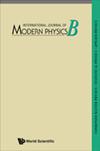Development of multi-directional piezoelectric sensor doped with graphene by near-field electrospinning technology for calligraphy writing
IF 2.8
4区 物理与天体物理
Q2 PHYSICS, APPLIED
引用次数: 0
Abstract
A novel multi-directional (MD) circular-shaped fiber piezoelectric sensor was developed to detect calligraphy writing force from various directions quantitatively. The sensor was fabricated using polyvinylidene fluoride (PVDF) piezoelectric fibers doped with Graphene and spun using direct-write near-field electrospinning (NFES) technology. The NFES collector, designed as a rotating disc system, orderly collected the fibers to enhance the piezoelectric effect and dipole moments, forming the circular sensor. Flexible electrical electrodes with multiple signal output circuits were incorporated for calligraphy stroke sensing, bonded with circular PVDF fibers to create the flexible MD sensor. With inner and outer diameters of 20[Formula: see text]mm and 60[Formula: see text]mm, the circular sensor responded to deformable signals induced by calligraphy strokes. Parameters of sensor fabrication were optimized using the uniform design experimental method. Calibration involved tapping tests at 1–10[Formula: see text]Hz to correlate fiber output voltage with the corresponding force. The single sensor reached a maximum voltage output of approximately 908[Formula: see text]mV and detected forces ranging from 0.1 to 50[Formula: see text]N. After validating the MD circular-shaped piezoelectric sensor, a [Formula: see text] sensor array was configured for calligraphy writing force sensing, providing quantitative measurements of dynamic responses during writing, valuable as a data source for apprentice learning.利用近场电纺丝技术开发掺杂石墨烯的多向压电传感器,用于书法书写
本研究开发了一种新型多方向(MD)环形纤维压电传感器,用于定量检测来自不同方向的书法书写力。该传感器采用掺杂石墨烯的聚偏二氟乙烯(PVDF)压电纤维,利用直写近场电纺(NFES)技术纺制而成。设计为旋转圆盘系统的 NFES 收集器有序地收集纤维,以增强压电效应和偶极矩,从而形成圆形传感器。用于书法笔画感应的柔性电极带有多个信号输出电路,与圆形 PVDF 纤维粘合在一起,形成柔性 MD 传感器。圆形传感器的内径和外径分别为 20[式中:见正文]毫米和 60[式中:见正文]毫米,能对书法笔画引起的可变形信号做出响应。采用统一设计实验法对传感器的制造参数进行了优化。校准包括 1-10[公式:见正文]赫兹的敲击测试,以便将纤维输出电压与相应的力相关联。单个传感器的最大电压输出约为 908[式中:见正文]mV,可检测到 0.1 至 50[式中:见正文]N 的力。在对 MD 圆形压电传感器进行验证后,[公式:见正文] 传感器阵列被配置用于书法书写力感应,对书写过程中的动态响应进行定量测量,为学徒学习提供了宝贵的数据源。
本文章由计算机程序翻译,如有差异,请以英文原文为准。
求助全文
约1分钟内获得全文
求助全文
来源期刊

International Journal of Modern Physics B
物理-物理:凝聚态物理
CiteScore
3.70
自引率
11.80%
发文量
417
审稿时长
3.1 months
期刊介绍:
Launched in 1987, the International Journal of Modern Physics B covers the most important aspects and the latest developments in Condensed Matter Physics, Statistical Physics, as well as Atomic, Molecular and Optical Physics. A strong emphasis is placed on topics of current interest, such as cold atoms and molecules, new topological materials and phases, and novel low dimensional materials. One unique feature of this journal is its review section which contains articles with permanent research value besides the state-of-the-art research work in the relevant subject areas.
 求助内容:
求助内容: 应助结果提醒方式:
应助结果提醒方式:


